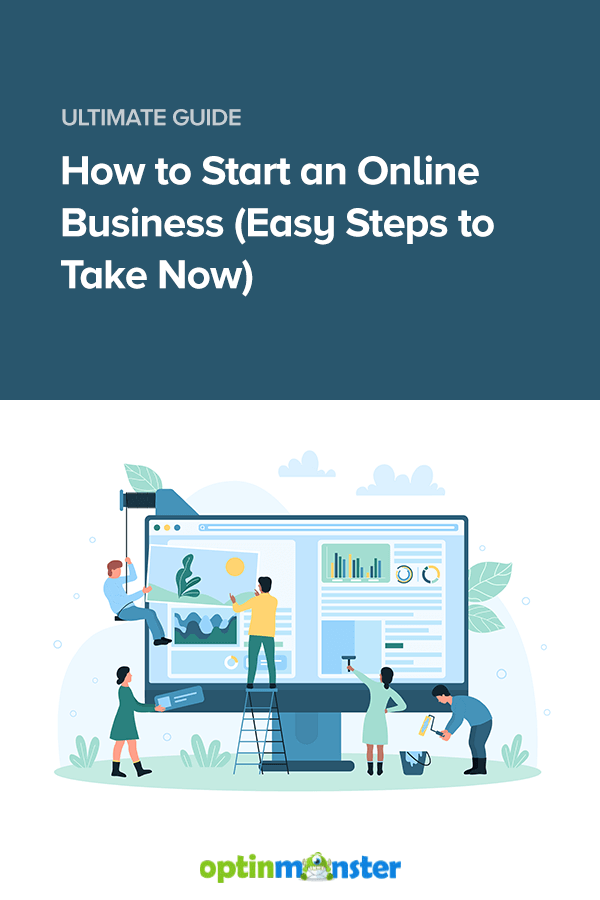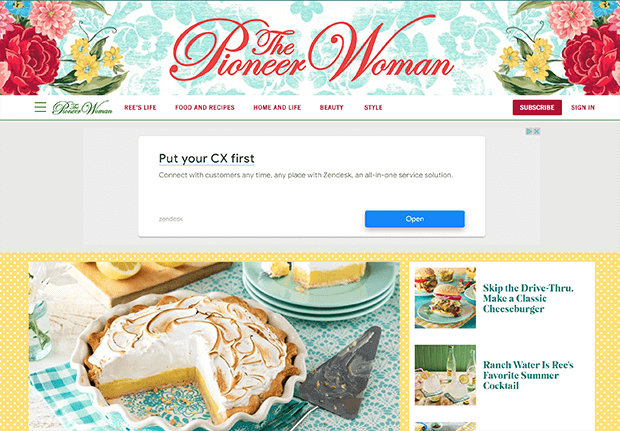Want to know how to start an online business?
You don’t need lots of money or even the most unique business idea ever imagined. All you need is a plan, a lot of persistence, and some patience. We’re here to help!
This ultimate guide will walk you through planning your online business from just a dream to launching and growing. You’ll find lots of resources and ideas if you want to dig deeper.
Let’s dive right in!
- What is an Online Business?
- Advantages of Starting an Online Business
- How to Start an Online Business
- 19 Online Business Ideas
- Next Steps: Growing Your Online Business
What is an Online Business?
An online business is simply a business that sells products, services, or advertising through the Internet instead of a physical storefront.
You’re probably familiar with big-name online businesses like Amazon, eBay, or Google. But there are plenty of small business owners who are also successfully running their own businesses or side hustles online.
Some examples of online businesses that sell products include OptinMonster, SeedProd, or WPForms. These companies sell software and plugins to other entrepreneurs. You could also launch an eCommerce website selling physical products online.
Online service providers might include copywriters, web developers, graphic designers, and other digital creators.
You can even sell advertising as your online business model. Bloggers like Pioneer Woman are perhaps the original online entrepreneurs. They earn money through advertising or sponsored content. Influencers are another type of online business that relies on selling access to an audience.
Advantages of Starting an Online Business
Online entrepreneurship is popular for good reason. There are many advantages to starting a new business online.
First, your startup costs can be much lower than starting a traditional brick and mortar business. All you need to get started is your own website and an email list. You can even start with just a social media account. Your ongoing overhead costs tend to be lower as well, since you don’t have to pay rent or utilities on a physical storefront.
Online businesses also have a larger market reach. You’re not limited to people nearby who can visit your store. You may be able to reach potential customers all over the world. Even beginners without a website can sell their products on virtual marketplaces like Etsy and make money online.
Finally, online businesses can often be automated, which can save you time, money, and energy. Instead of hiring someone to physically check out orders for customers, you can set up an eCommerce store that sells products automatically around the clock. There are ways to automate just about every business process online, from sales to marketing to customer service.
Now let’s dive into how to get started with your online business.
How to Start an Online Business
Step 1: Self-Reflection
The first step is self-reflection. We know you’re probably excited to purchase a domain name and start designing your logo. But before you do that, it’s important to make a solid business plan.
Instead of blindly copying what everyone else is doing, we suggest looking inward first. After all, you will be the one running the business day-to-day. It’s important that your business model reflects your strengths and interests.
Start by asking yourself some simple questions:
- What are you good at?
- What do you enjoy doing?
- What kind of people do you like working with?
Once you’ve identified some skills and passions, start thinking about practical questions like:
- How much time do you want to spend on your business?
- Is your business a side gig or your main source of income?
- How do you want to spend your time? Would you rather interact with clients or customers directly, create products, or build a platform?
Use your answers to these questions to identify the problem you want to solve for your customers. Then brainstorm ways that you can solve it.
You don’t have to pick a solution yet. You’ll want to do some market research first.
Step 2: Market Research
Once you’ve picked a problem to solve, it’s time to do some research. After all, the best business idea in the world will flop if no one is actually interested in buying.
Remember: people don’t buy products or services even though that’s what it looks like on the outside. They’re actually buying solutions to a problem that they have.
Identify a target market that experiences the problem you want to solve. You can build a basic customer profile but don’t spend too long trying to figure out how old they are or what kind of care they drive. Focus on the problem.
Make sure you understand:
- How does this problem affect their life?
- What will happen if this problem isn’t solved?
- What else have they tried to solve this problem? What worked and what didn’t?
- How much are they willing to pay to have this problem solved?
- How will they access an online solution to this problem?
There are several ways to get answers. You can interview potential customers directly. Another option is to collect feedback with a customer feedback survey. Even if you don’t have customers yet, you can survey people who might fit your target audience.
You can also look at search data to see what people are searching for related to this problem. Tools like SEMRush can tell you how many people are searching for specific terms. This can give you an idea of how much demand there is for your solution.
You may find that you need to adjust your ideas based on market research, and that’s okay. It’s much better to do the research now, before you invest a lot of resources in creating a product or service that nobody really wants. And remember to keep your self-reflection in mind too. You don’t have to do everything that the market research suggests. Just use it to inform your business model and planning.
Step 3: Business Model
Next, you need to choose a business model. This decision should be based on both your availability and resources as well as the needs of the market. Here are 6 common online business models to consider:
Affiliate Marketing or Influencing
If you have a blog, podcast, social media account, or other platform, you can earn commissions for promoting other people’s products and services online. Both affiliate marketing and influencing require you to create content consistently and build an audience.
Freelancing
You can use your skills in digital marketing, writing, designing, or programming to serve individuals or businesses. It’s easy to start freelancing on sites like Upwork, though many freelancers eventually establish their own business websites and client lists. With freelancing, you can earn money as long as you’re working. Freelancers have flexibility to set their own schedules and pricing.
Coaching and Consulting
If you’re an expert at something, you can become a coach or consultant teaching others what you know instead of doing it for them like a freelancer. Many customers want to learn how to do something on their own instead of paying someone to do it for them long-term. Coaches can provide guidance for personal or professional transformation.
Digital Products
For people who may not be able or willing to work directly with clients very much, you can package your expertise into digital products. This could be eBooks, worksheets, templates, and online courses. You would then spend the majority of your time on online marketing rather than direct service to clients. This can be an option for more passive income compared to other business models.
Software as a Service (SaaS)
If you know how to program, you can create a piece of software or application that solves a problem. Then you can sell the software as a recurring subscription. Like other information products, SaaS businesses spend more of their time on product development and marketing strategy.
eCommerce
You can set up an online store with an eCommerce platform like Shopify to sell physical products. These can be handmade products that you create. Or you can use a dropshipping business model to select and source products from vendors and manufacturers.
Once you have a business model in mind, it’s time to take a look at the competition.
Step 4: Competitor Research
It’s important to understand your competitors. But we don’t want you to copy them! In fact, the main purpose of competitor research is to figure out how you will be different.
As always, focus first on the customer’s problem rather than the thing you want to sell. Look online to see who else is trying to solve this problem. Find out what they’re doing to solve it. Is it a product? A service? Information? Compare this to your business model and look for strengths and weaknesses.
Another important thing to research is your competitors’ customer experience. If you have the resources, you could order something and experience their processes firsthand. Many customers will choose the brand that makes them feel best, not necessarily the best solution.
You can also take a look at their marketing channels. What kind of content are they posting? How does their audience respond to their marketing? You can even ask people from your target market to look at your competitors and describe how they feel and think about the brand.
Check out our list of competitor research tools you can use to gain more insight.
With all of this important information ready, you can now write your unique value proposition.
Step 5: Unique Value Proposition
Your unique value proposition (UVP) is way more than just a line to put on your business plan. It’s a powerful statement about the unique benefits of your product or service.
The UVP for your business will drive all of your branding and marketing strategy. In some ways, you can also think of it as the niche for your business. When someone reads your UVP, they should quickly understand:
- What problem are you solving?
- Who are you solving it for?
- What is the solution?
- What makes your solution unique?
Let’s look at a few examples:
Example 1:
- Target Market: Parents of young children
- Problem: Difficulty in finding safe and engaging toys for children
- Solution: A subscription service that delivers high-quality, educational toys to children on a regular basis.
Unique Value Proposition: Our subscription service provides parents with a convenient and affordable way to access high-quality toys that are both fun and educational, helping children learn and grow.
Example 2:
- Target Market: Fitness enthusiasts
- Problem: Limited access to gym equipment during pandemic lockdowns
- Solution: A fitness app that provides personalized home workout plans, complete with instructional videos and progress tracking features.
Unique Value Proposition: Our app creates personalized workouts tailored to each user’s fitness level and equipment availability, helping them achieve their fitness goals from home.
Example 3:
- Target Market: Pet owners
- Problem: Difficulty in cleaning up pet hair and messes
- Solution: A handheld vacuum designed specifically for pet hair and messes, with strong suction and specialized attachments.
Unique Value Proposition: Our handheld vacuum makes cleaning up after pets a breeze, with powerful suction and specialized tools that make it easy to tackle even the toughest messes.
Step 6: Legal Formation
You’ve done all the planning and research. Now it’s finally time to start doing!
To set your business up for success, you will need to officially register your business name and entity with the appropriate government authorities. You may need to get special permits or licenses and apply for state and federal tax ID numbers. It’s also best practice to get a separate bank account for your business rather than using your personal bank account.
Here’s a quick overview of common business structures in the United States:
- Sole proprietorship: This is the simplest structure, but you are personally responsible for any debts or legal issues.
- Partnership: This is when you start a business with a partner. You both share the profits and liabilities. However, like sole proprietorship, you are personally responsible for any debts or legal issues.
- Limited liability company (LLC): This structure offers limited liability, meaning your personal assets are protected if something goes wrong with the business. It’s a popular choice for small businesses because it’s simple to set up and maintain.
- Corporation: This structure also provides limited liability, but it’s more complicated to set up and maintain. It may be a good choice depending on your circumstances.
We’re conversion rate experts, not legal experts, so we always recommend checking with a qualified professional to find what works best for your business.
Step 7: Sales Platform
Next, you need to create a way to sell online. In most cases, this will be a website.
For affiliate marketers, you’ll need to start a blog to publish content and affiliate links.
Freelancers, coaches, and consultants will need a business website and perhaps a customer relationship management (CRM) tool to track leads, send contracts and invoices, and handle the digital paperwork for your business.
Online store owners will need an online shopping site. There are plenty of eCommerce plugins and platforms you can use whether you’re selling digital or physical products.
Another option for product-based businesses is to sell on marketplaces like Amazon, Etsy, or Code Canyon. This can be a good way to find a bigger audience, but you’ll have to pay fees for listing and selling. We recommend using marketplaces to enhance your own sales platform.
You will also need a way to accept payments online. Payment processors like Stripe or Paypal can take credit card, ACH, and other digital payments through your website.
Once your sales platform is done, you can work on your marketing channels.
Step 8: Marketing Channels
There are tons of digital marketing channels available. The best choice will depend on your available resources and your target audience. Marketing channels should drive customers toward your main sales platform to make their purchase.
Here are some popular marketing channels to try:
- Email marketing: Send your subscribers promotional emails about new products, special offers, and more.
- Social media marketing: Share content on social media that engages your target audience and builds trust.
- Direct outreach: Pitch your service or product directly to customers either through cold outreach or networking.
- Search engine optimization: Attract search traffic to your website, typically through optimized content and link-building.
- Paid advertising: Buy ads on platforms like Facebook, LinkedIn, Google, and YouTube to build brand awareness.
- Influencer marketing: Team up with influencers to promote your products to their existing audience.
- Referral marketing: Reward existing customers for recommending your business to their friends and colleagues
Once you pick one or more marketing channels, your online business is ready to go! Now it’s a matter of running the business, gathering data from your customers, and improving.
If you want to discover the latest digital marketing trends, opportunities, and challenges, read these Mind-Blowing Digital Marketing Statistics to Learn From.
Before we wrap up, we wanted to give you some specific online business ideas for inspiration.
19 Online Business Ideas
- Blogging: Writing and publishing articles online on a topic you’re interested in.
- Bookkeeping and accounting: Helping businesses keep track of their finances and prepare for tax season.
- Coaching: Helping people reach their personal or professional goals.
- Digital products: Creating and selling products like e-books, printables, or digital art.
- Dropshipping: Selling products online without actually handling or storing inventory yourself.
- Graphic design: Creating visuals like logos or web designs for clients.
- Handmade products: Making and selling products like jewelry or crafts that you make yourself
- Influencer: Sharing your life and opinions on social media and getting paid to promote products or brands.
- Freelance writing: Writing content for clients and getting paid for your work.
- Membership site: Creating a website where users can access exclusive content for a monthly or yearly fee.
- Online course: Creating and selling courses on a topic you’re knowledgeable about.
- Paid email newsletter: Offering exclusive content or information to subscribers for a fee.
- Podcasting: Creating and hosting a show where you discuss a particular topic or interview guests.
- Reselling: Buying and reselling products for a profit, often on platforms like eBay or Poshmark.
- SaaS product: Creating and selling software or apps.
- Social media manager: Managing social media accounts for other businesses or individuals.
- Subscription box: Creating a monthly box filled with products related to a specific theme or interest.
- Translation and transcribing: Translating documents into another language or creating a text transcript of audio files.
- Virtual assistant: Helping other business owners manage their workload by completing tasks remotely.
Next Steps: Growing Your Online Business
We hope this guide was helpful in showing you how to start an online business. As you grow, check out these other resources:
- Best WordPress Plugins to Grow Your Business
- Best Website Builders For Small Businesses Compared
- Best Email Automation Tools to Transform Your Business
No matter what your online business model, OptinMonster can help you get more traffic, conversions, and sales. Give OptinMonster a try risk-free today!






















Add a Comment